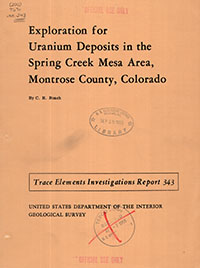Exploration for uranium deposits in the Spring Creek Mesa area, Montrose County, Colorado
Links
- Document: Report
- Plates:
- Download citation as: RIS | Dublin Core
Abstract
The U.S. Geological Survey explored the Spring Creek Mesa area from July 11, 1951, to August 14, 1953. During that period, 280 diamond-drill holes were completed for a total of 180,287 feet.
Sedimentary rocks of Mesozoic age are exposed in and adjacent to the Spring Creek Mesa area. These rocks consist of, from oldest to youngest: the Upper Jurassic Morrison formation, the Lower Cretaceous Burro Canyon formation, and the Upper Cretaceous Dakota formation.
The Morrison formation consists of two members in the Spring Creek Mesa area: the lower is the Salt Wash member and the upper is the Brusby Basin member. All of the large uranium-bearing deposits discovered by the Geological Survey drilling in the Spring Creek Mesa area are in a series of coalescing sandstone lenses in the uppermost part of the Salt Wash member of the Morrison formation. Most of the ore deposits are believed to be irregular tabular or lens-shaped masses and probably lie parallel to the bedding, although in detail, they may crosscut the bedding. Also, ore deposits that take the form of narrow elongate concretionary-like structures, locally called “rolls”, may be present in the Spring Creek Mesa area. The mineralized material consists mostly of sandstone which has been selectively impregnated and in part replaced by uranium and vanadium minerals. Also, rich concentrations of uranium and vanadium are commonly associated with thin mudstone seams, beds of mudstone pebbles, and carbonaceous material of various types. Two suites of ore minerals are present in the ore deposits - - an oxidized suite of secondary uranium and vanadium minerals and a relatively unoxidized suite of “primary” uranium and vanadium minerals.
The following geologic criteria are useful as guides to ore in the Spring Creek Mesa area:
1. Large ore deposits generally occur where the “ore-bearing sandstone” is more than 40 feet thick.
2. The color of the mudstone associated with the “ore-bearing sandstone” in the vicinity of large ore deposits is commonly gray instead of the usual red.
3. The “ore-bearing sandstone” is normally a light red, but in the vicinity of oxidized ore deposits it is light brown and in the vicinity of relatively unoxidized ore deposits it is gray.
4. The “ore-bearing sandstone” in the vicinity of relatively unoxidized ore deposits commonly contains sparse to abundant disseminated pyrite. In the vicinity of oxidized deposits it commonly contains abundant limonite spots and widespread limonite staining.
Study Area
| Publication type | Report |
|---|---|
| Publication Subtype | USGS Numbered Series |
| Title | Exploration for uranium deposits in the Spring Creek Mesa area, Montrose County, Colorado |
| Series title | Trace Elements Investigations |
| Series number | 343 |
| DOI | 10.3133/tei343 |
| Year Published | 1954 |
| Language | English |
| Publisher | U.S. Geological Survey |
| Description | Report: 55 p.; 2 Plates: 24.57 x 36.66 inches and 42.16 x 28.38 inches |
| Country | United States |
| State | Colorado |
| County | Montrose County |
| Other Geospatial | Spring Creek Mesa |


